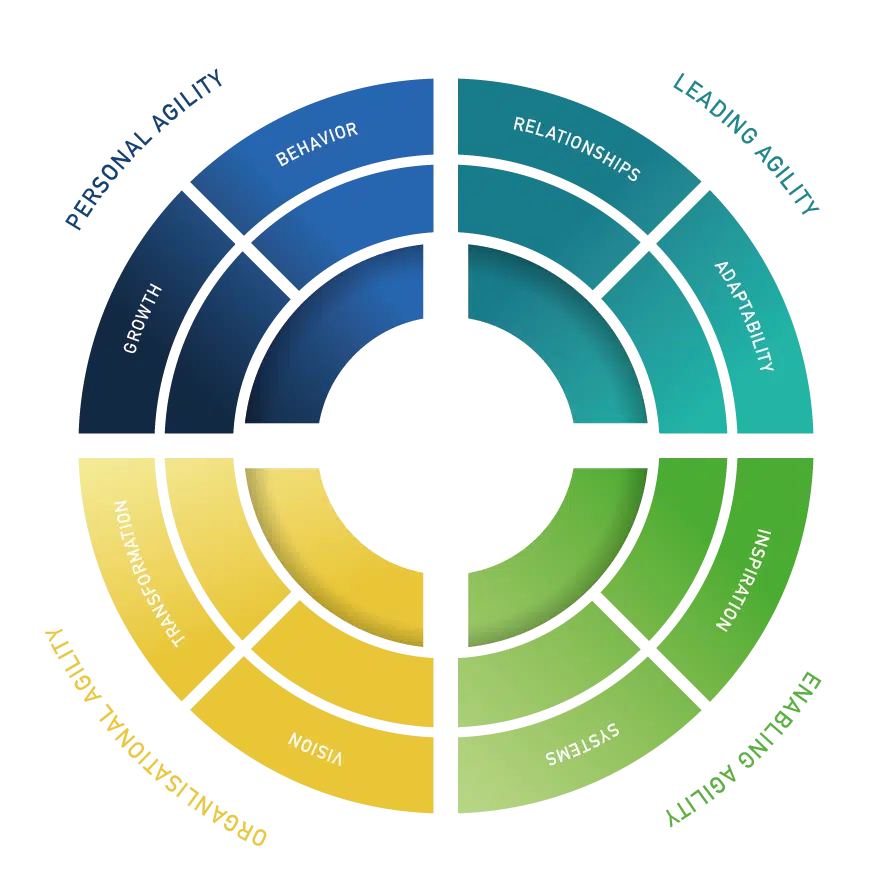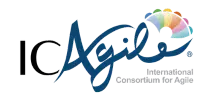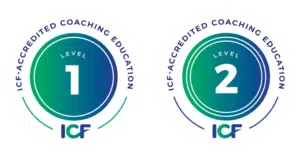In my years of coaching leaders through the maze of Agile transformation, I’ve encountered an intriguing paradox: organizations eagerly adopt Agile methodologies, yet their leaders often neglect the personal agility needed to truly champion these changes. This oversight is akin to expecting a garden to thrive without nurturing the soil. Here lies the essence of personal agility—cultivating an inner landscape that fosters growth, adaptability, and resilience. Helping leaders understand leadership agility is in my view one of the largest success factors towards reaching Agility in the organization.
The Leadership Agility Circle – A Compass for sustainable change

When working with people in leadership positions, I’ve recognized the need for a comprehensive tool that addresses the multifaceted nature of being part of the Agile transformation in that role.
The Leadership Agility Circle is our answer to this need—a holistic framework designed to navigate the complex landscape of Agile leadership. Within this compass, the quadrant of “Personal Agility” stands out as a critical foundation.
Navigating the Quadrant of Personal leadership Agility
At the heart of Agile leadership lies the principle of personal leadership agility. It’s about more than just implementing Agile practices within teams and projects; it’s about embodying the flexibility, resilience, and proactive mindset that define Agile at a personal level. The Personal leadership Agility Plan serves as a blueprint for leaders seeking to cultivate these qualities, offering a structured yet flexible approach to self-development.
Embracing Adaptability and Courageous Leadership
At the heart of this quadrant is the recognition that true leadership agility development extends well beyond the mere acquisition of skills. It’s about nurturing the capacity to face new challenges with a mindset that is both open and brave. Leaders are called to embrace adaptability, viewing each new situation as an opportunity for growth and learning rather than a hurdle to overcome.
Cultivating a Growth Mindset and Vertical Development
Leaders are encouraged to engage in a deeper exploration of their own growth mindset, fostering an expanded understanding of their personal and professional evolution. This involves a critical examination of one’s mental models, enhancing self-awareness, and effectively navigating emotional responses. It’s about seeing growth not as a linear path but as a vertical expansion of understanding and perspective.
Challenging Personal Limits and Embracing Self-Leadership
This quadrant underscores the criticality of venturing beyond one’s comfort zones. It champions the virtues of actively soliciting feedback, engaging in continuous self-reflection, and acknowledging the profound impact one’s leadership style has on others. The emphasis is on self-leadership—a journey of self-discovery, pushing personal boundaries, and leading by example.
Advancing into a Broader Comprehension of Personal Mindset Growth
A pivotal aspect of this quadrant is the encouragement of vertical development, inviting leaders to deepen their insight into their own mindset and its evolution. This transcends simple skill enhancement, steering towards a comprehensive understanding of how one’s mindset shapes their leadership agility journey. Leaders are guided to reflect on their growth, recognize their development stages, and embrace the transformative path towards becoming more agile, resilient, and emotionally intelligent leaders.
Agile process improvement – Why stop there?
Continuous improvement is not just a methodology for processes but a philosophy for life. Each step forward opens new doors, reveals further possibilities, and enhances our understanding of ourselves and the world around us.
Choosing to start uncovering your own leadership agility is about embracing growth as a never-ending path. The landscape of our personal and professional lives is always changing, and with each change comes new challenges and opportunities for growth. By continuing to improve, we equip ourselves with the agility to adapt to these changes, to overcome obstacles, and to seize opportunities.
Moreover, the journey of improvement is inherently rewarding. It feeds our curiosity, fuels our motivation, and enriches our experiences. Each achievement and lesson learned on this path adds layers to our character and depth to our understanding, making the journey as rewarding as the destination.
When we decide to start improving, the question of why stop becomes rhetorical. Why would we choose stagnation when growth offers so much more? The pursuit of improvement is a testament to our belief in our potential and our commitment to realizing it. It’s a journey that, once begun, becomes a part of who we are as leader and who we aspire to be fr our organization, our teams and our customers.
Starting Somewhere, Anywhere
The journey through the Personal Leadership Agility Development plan is less about the sequence and more about the initiation. Dive in with an open heart and a curious mind. Let intuition guide your first steps. The plan isn’t a formula; it’s a framework for exploration, designed to adapt to your unique journey toward personal agility.
Personal Value Proposition
The first step in creating your Personal leadership Agility Plan involves defining your unique value proposition in an Agile context. When an organization transitions to more adaptive ways of working, each individual’s value becomes a unique contribution to the collective mission. The challenge lies in articulating this value, especially in a shifting organizational context. What distinct qualities do you bring to the table? How does your personal evolution toward leadership agility enhance the collective agility of your organization? Identifying your value proposition is crucial for aligning your personal growth with the broader goals of Agile transformation.
Take time to reflect on your impact on the organization’s ultimate goals; How does your evolution into a more Agile version of yourself enhance the organization’s agility? This introspection is crucial, not only for personal growth but for reinforcing your indispensable role in an Agile transformation
Set small goals for your Leadership Agility
Transitioning to Agile ways of working is fraught with challenges, demanding a clear personal vision and tangible goals. What personal milestones align with your desire for leadership agility? These goals should not only stretch your capabilities but also be attainable, serving as stepping stones rather than distant stars.
Clarifying your goals is essential for navigating the path to personal leadership agility. These goals should be specific, measurable, attainable, relevant, and time-bound (SMART). They serve as your North Star, guiding your actions and decisions as you embrace the Agile mindset.
Harnessing Your Strengths
In the context of leadership agility, understanding and leveraging your individual strengths is not just about personal growth—it’s about inspiring and guiding your team through the Agile transformation with confidence and effectiveness. Leaders who are aware of their unique strengths can model agility in action, demonstrating how to adapt and thrive amidst change. This self-awareness becomes a beacon for others, showing that leadership in Agile is as much about personal evolution as it is about process improvement.
Moreover, when leaders recognize their own traits and experiences that contribute positively to an Agile environment, they can more effectively align their leadership style with Agile values and principles. This alignment enhances the leader’s ability to foster a culture of continuous improvement, collaboration, and customer focus within their teams. It empowers them to tackle the complexities of transformation by drawing on their strengths, such as resilience in the face of setbacks, creativity in solving problems, or empathy in understanding team dynamics.
By embracing this deep level of self-awareness, leaders in Agile settings become champions of change, not only by what they do but by who they are. They create an environment where their strengths catalyze growth and innovation, encouraging their teams to also identify and leverage their own strengths. This creates a virtuous cycle of learning and adaptation that is the hallmark of a truly Agile organization. In doing so, leaders not only navigate the transformation with confidence and resilience but also embed these qualities into the fabric of their teams, ensuring that agility is a sustained, collective achievement.
Cultivating Agile Interactions
The shift to leadership Agility requires a cultural metamorphosis, particularly in how we engage with others. This transformation demands transparency, trust, and a willingness to embrace failure as a pathway to learning. Reflect on your interactions and challenge yourself to embody the principles of Agile in every conversation, every collaboration.
Assessing Your Environment
Your physical and digital environments play a significant role in supporting your Agile journey. Assess and adjust your surroundings to remove impediments to agility. This could mean reconfiguring your workspace, adopting new tools, or establishing routines that promote flexibility and responsiveness.Your surroundings can significantly impact your ability to embrace agility. What supports your Agile journey, and what hinders it? Small environmental adjustments can have profound effects on your personal agility.
Confronting Inner Barriers: Enhance your Self-leadership
The greatest obstacle to personal leadership agility often lies within us. Acknowledging and addressing our internal barriers is a vital step toward genuine self-leadership. This introspection requires honesty and courage, shedding light on the shadows that might impede our path to agility.Acknowledging and addressing internal barriers is perhaps the most challenging aspect of personal agility. The Personal leadership Agility Plan invites you to introspectively identify how you might be hindering your own Agile journey and to develop strategies for overcoming these self-imposed limits.
Envisioning Desired Changes – Start with end in mind
Now you have set yourself up for success, it is time to get started. Take a moment to envision the future you and what you and your teams would notice about yourself if you had reached your outcome. You visualize the success you strive for, feeling it as if it’s already been achieved. With that vivid image as your guide, you start tracing the steps backward. Asking yourself “What would success look like for me and others” will give a clear idea of what you set as measurements for success. Going through this activity can also be used to explore goals and habit changes you didn’t envision at first.
Adaptive Action 2.0 – Check your actions
With your intentions laid out, use the adapted version of Glenda Eyong’s “adaptive Action framework to navigate your adaptive action towards your goals:
What? – Identify the action or change you’re considering.
So What? – Reflect on the significance of this action. Why is it important, and what impact could it have on your personal leadership agility?
Now What? – Determine the immediate steps you’ll take to initiate this action. What specific strategies will you employ to address your internal barriers?
Then What? – Anticipate the future consequences of your action. How will it affect the larger system you wish to enable and what further actions might it necessitate?
Feedback & Continuous improvement
As a leader, you understand the power of feedback in shaping your path to success. Your Personal Leadership Agility Plan is a testament to your commitment to growth and adaptability. However, the journey toward excellence is not one you should navigate alone. Embrace the insights of your loving critics—those trusted mentors, colleagues, and friends who offer you honest, constructive feedback with your best interests at heart.
Incorporate their perspectives into your leadership agility plan regularly. This doesn’t mean changing course with every piece of advice but rather, carefully considering which feedback aligns with your goals and values. Use it to refine your strategies, enhance your leadership skills, and navigate the complexities of your role with greater precision.
Remember, continuous improvement is the hallmark of a truly agile leader. By actively seeking and integrating feedback from your those you know will speak honestly about how you are impacting the organization, you ensure that your Personal Agility Plan remains a living document, one that evolves with you and propels you toward your vision of success. Stay open, stay adaptable, and let the journey of continuous learning lead you to new heights of leadership excellence.











